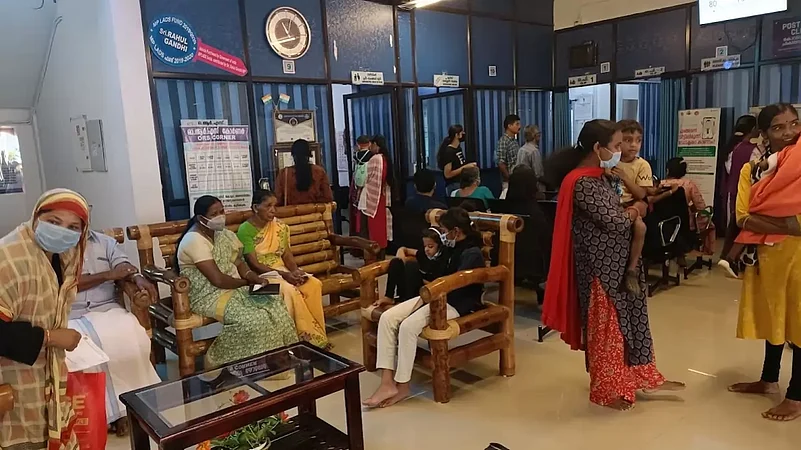Kerala does not fall in the list of the first 10 rich states in India, but the state has consistently been ranked on top in multiple indicators of social development such as literacy, healthcare, education, and standard of living.
Likewise, Kerala is not there in the list of the first 10 states having the largest number of industrial units, according to the statistics provided by the government. Kerala’s rank in this regard is only 12th with only 7,796 factories, but the state is among the top 10 states in terms of per capita GSDP (gross state domestic product), which is above the national average.
Apparently, Kerala emerged as the least poor state in the country for a consecutive second time with 0.55 per cent in the Multidimensional Poverty Index (MPI) released by Niti Aayog. Ernakulam district in Kerala is the only district in India that has zero poverty. In the 2022 MPI, Kerala’s Kottayam district was marked as the only district in the country having zero per cent poverty.
The MPI has three equally weighed dimensions based on 12 indicators such as nutrition, years of schooling, child and adolescent mortality, maternal health, school attendance, cooking fuel, sanitation, drinking water, electricity, housing, assets and bank account. Kerala’s impressive scores across all indicators reflect the state’s strong foundation in human development and social security despite having no excellent track record in industrial growth.
The significant reduction in poverty in both rural and urban areas of Kerala can be attributed to a series of radical policy decisions that have been implemented over the past four decades. Land reforms, universal and compulsory school education, democratic decentralisation process, and healthcare initiatives have played a crucial role in uplifting the marginalised sections of society.
Extensive social security schemes and a robust public distribution system (PDS) have provided a safety net for vulnerable populations, ensuring access to basic necessities. The social security pension system in Kerala provides assistance to approximately 65 lakh people, playing a crucial role in alleviating hunger and addressing socio-economic vulnerabilities. Women empowerment programmes like Kudumbasree have empowered women and improved their socio-economic status.
These collective interventions, as per official statistics, have led to a sharp and fast decline in the absolute poverty ratio, showcasing the remarkable success of Kerala’s comprehensive approach to poverty eradication. According to official statistics, the absolute poverty rate was 59.79 per cent in 1973-74, which was worse than the national average of 54.88 per cent. But over a period of 40 years, Kerala has reduced absolute poverty to 11 per cent (2011-12) whereas the national average was 29.5 per cent.
A Robust healthcare system
Kerala occupies the top rank in multiple health indicators such as highest life expectancy, lowest maternal mortality, and infant mortality. According to the latest National Family Health Survey (NFHS), Kerala is the only state having a single digit number of infant mortality (6 per 1,000 live births) among the larger states in the country.
Since 2019, the Primary Health Centres (PHCs) in Kerala have been listed among the top that acquired the National Quality Assurance Certification by the National Health Mission. In the 2020 list, all the first 12 best performing PHCs in India were from Kerala. The state has a three-tier primary health care system consisting of 24x7 PHCs, Community Health Centres and Family Health Centres. The system includes several sub centres as well.
Decentralised planning
Kerala has a rich history of decentralised planning and governance. Kerala launched the ‘People’s Planning Programme’ in 1996 during the 8th Five Year Plan, which brought revolutionary changes in the Panchayati Raj and community level planning and implementation processes. Kerala pioneered grassroot level planning by transferring 40 per cent of the plan fund to the panchayats. A number of powers entrusted with the state government were transferred to the local self bodies, including the administration of hospitals, schools, and krishi bhavans. Besides, the delivery of centrally-sponsored schemes such as the National Rural Employment Guarantee Scheme was also transferred to the local bodies.
“Kerala has evolved a sound and effective fiscal decentralisation system, and a share of state taxes and grants are transferred to the LGs to meet their expenditure based on the recommendations of successive State Finance Commissions (SFCs). In the past, Kerala also had a history of timely constitution of SFCs and implementation of their recommendations on devolution,” says B A Prakash, Chairman of the Fifth State Finance Commission in Kerala.
In an article in the Economic and Political Weekly in March 2018, Prakash pointed out that Kerala had made remarkable strides in comparison to other Indian states through the effective transfer of powers and functions, the establishment of decentralised governance, fiscal decentralisation, and successful implementation of decentralised planning.
School education
Kerala has consistently retained its fame as the most literate state in India across both male and female populations. Kerala is one of the few states having a very low dropout rate across all levels of school education. As recorded, the 2021-22 dropout rate of the state was 0.02 per cent in the lower primary level. This is 0.03 and 0.05 per cent in upper primary and high school levels respectively. This is far below to the national average of 4.13 per cent (lower primary). The national average of the dropout rate in the secondary level (high school) is a worrying figure of 17.06 per cent. The dropout rate of the SC/ST students is also significantly low in Kerala, which marks the lowest in the country with 0.04 and 0.03 per cent respectively.
Over the past few years, the state has witnessed a reverse trend of parents preferring public-funded schools instead of the private schools. Smart classrooms, renovated buildings, access to clean drinking water and sanitation facilities, modernised labs and library facilities attract parents and there is a significant rise in the enrolment in government schools. The Kerala Infrastructure Investment Fund Board (KIIFB) has selected 144 high schools to develop as ‘Centres of Excellence’ with an investment of Rs 5 crore on each school. According to the Chief Minister’s Office, around 10 lakh children have returned to the government schools in Kerala over a period of seven years.
Women’s empowerment
Kudumbasree, a unique Kerala experiment launched in 1997 for the eradication of poverty and comprising 4.5 million women as members, is the largest of its kind in the world.
Kudumbasree is essentially a community network that covers the entire state of Kerala. The programme operates on a three-tier structure: at the lowest level are the Neighbourhood Groups (NHGs), followed by the Area Development Societies (ADS) at the middle level, and the Community Development Societies (CDS) at the top, which are attached to the local self-government. The ADS acts as a federation of NHGs, while the CDS serves as a collective of ADS. By September 15, 2021, the Kudumbasree network had 2,94,436 NHGs affiliated to 19,489 ADSs and 1,064 CDSs with a total membership of 45,85,677 women. Membership to Kudumbasree is open to all adult women, limited to one membership per family.
More than 26,448 micro enterprises are being successfully run by Kudumbasree women in Kerala. Around 5 lakh members have been engaged in farming collectively and individually under various schemes of Kudumbasree. In addition, there are community kitchens, home shops, kiosks, digital marketing, health clubs, food on wheels, home stays, trade fares, capacity building programmes, occupational trainings and so on. Kudumbasree also runs palliative care, community counselling, gender training, children’s collectives and sanitation programmes.
Eradication of extreme poverty
The first announcement made by the Left Government in its second innings in 2021 was the complete eradication of extreme poverty. Soon after the swearing in May 2021, Chief Minister Pinarayi Vijayan announced the mission for the eradication of extreme poverty. The first step was to conduct a survey to identify the people living in extreme poverty, which is based on the absence of four factors: food, safe shelter, basic income, and health.
The survey was completed in a year and it was found that 64,006 families live in extreme poverty consisting of 1,03,099 individuals.
M B Rajesh, Minister for Local Self Government, says, “All factors were collectively taken into consideration. In Kerala, lack of income might not be the sole reason for the lack of food; there are other factors such as inability to cook food due to old age ailments or mental illness. Such factors have also been taken into account.”
The challenges ahead
However, Kerala has been facing unique challenges as well. A return of communicable diseases, which had once been eradicated, is a cause of worry for the state.
According to the State Economic Review of 2022, infectious diseases such as chikungunya, dengue, hepatitis, H1N1, leptospirosis and malaria are on the rise. A large number of people are infected by water-borne diseases such as diarrhoea every year leading to an impending crisis of the scarcity of clean drinking water.
Despite all glory, Kerala carries the burden of being the state having a very high prevalence of non-communicable diseases as well. The state is prone to diabetes, hypertension, cardiovascular diseases, cancer and lung diseases. Incidents of obesity, hyper lipedemia, heart attack and stroke are also high. Cancer mortality is extremely high among males in Kerala compared to the national average. A survey conducted by the Achutha Menon Centre for Health Science Studies, Thiruvananthapuram, reveals that one out of three has hypertension and one out of five has diabetes.





















